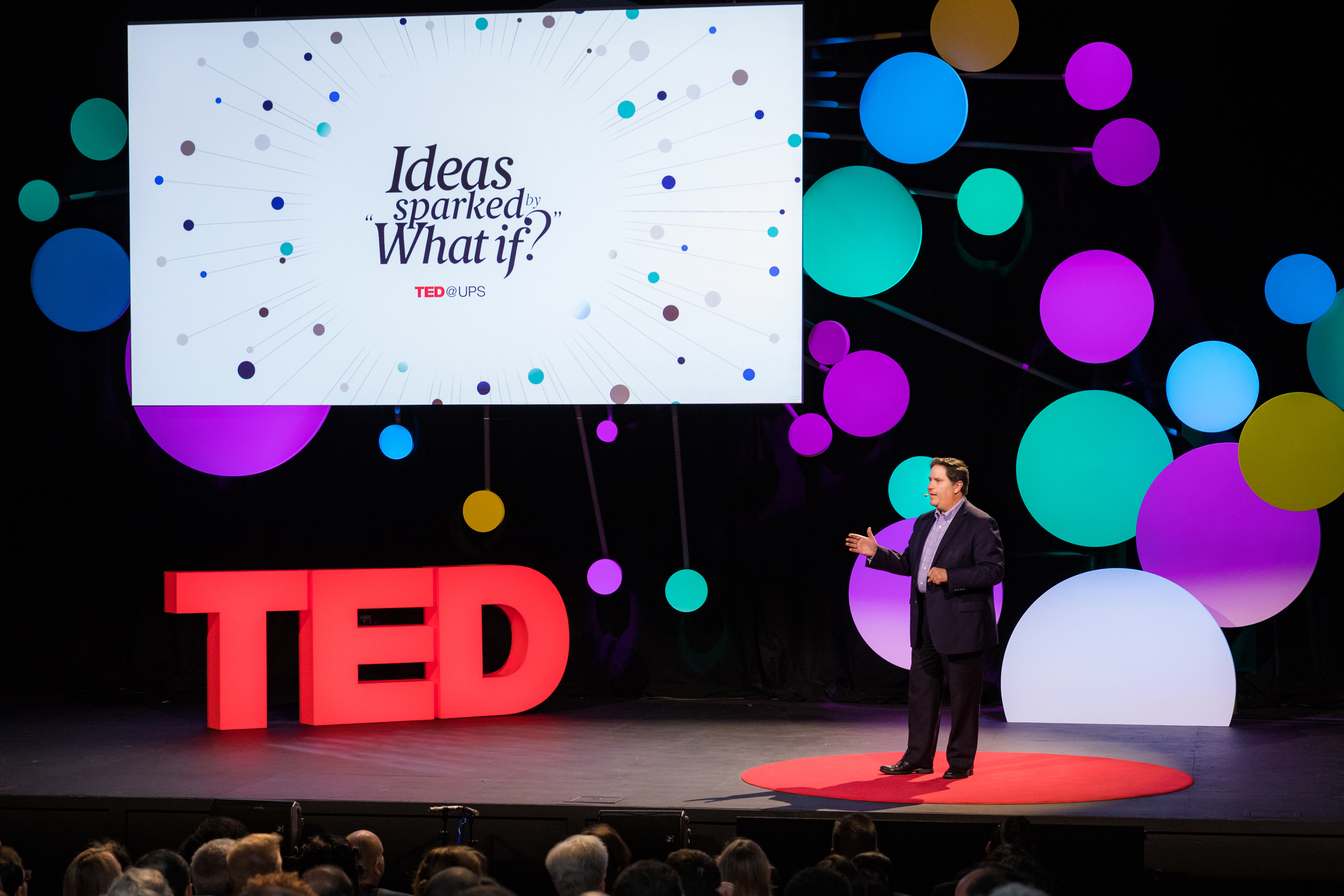
Juan Perez, UPS’s chief information and engineering officer, opens TED@UPS with a question: “What if?” (Photo: Ryan Lash / TED)
The greatest ideas of our time will be sparked by a simple question: “What if?”
What if we had truly inclusive workplaces? What if we removed the inefficiencies that stand in the way of eliminating world hunger? What if we could deliver quality health care in the home? What if we took back our privacy online? At this year’s TED@UPS — held on July 19, 2018, at SCADShow in Atlanta — TED and UPS partnered for the fourth year in a row to bring remarkable UPSers to the stage to explore these questions and more. In a time of uncertainty, global evolution and rapid innovation, their ideas on how to solve our most intractable problems have never been more important to hear.
After opening remarks from Juan Perez, UPS’s Chief Information and Engineering Officer, the talks in Session 1 …
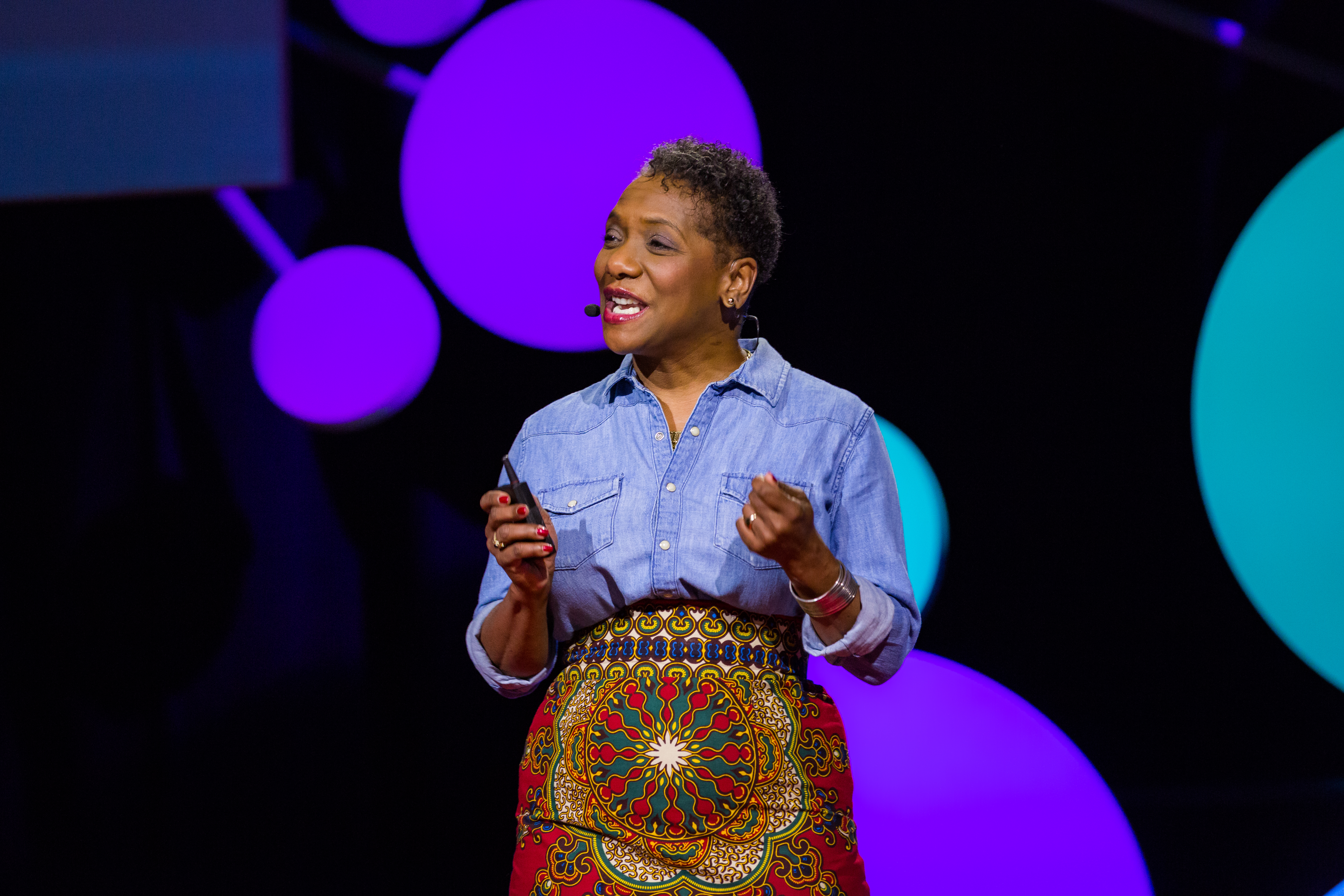
“The lessons we learn about diversity at work actually transform the things we do, think and say outside of work,” says Janet Marie Stovall. (Photo: Ryan Lash / TED)
Getting single-minded about racially diverse workplaces. Inclusion crusader Janet Marie Stovall asks us to imagine a place where people of all colors and all races are on and climbing every rung of the corporate ladder — where they “feel safe and indeed expected to bring their unassimilated, authentic selves to work every day, because the difference that they bring is both recognized and respected.” How do we get there? According to Stovall, companies must create an action plan that has three key components. The first is “real problems.” By 2045, the US population is projected to be predominantly non-white, and businesses that don’t mirror that diversity in their workforce and customer base are set up to fail. The second: “real numbers.” Businesses need to set specific diversity goals and commit to them, Stovall says. And if they don’t reach those numbers, there must be “real consequence” — Stovall’s third attribute. We spend one-third of our lives at our jobs, and if we can do so in inclusive, diverse environments, these benefits will be felt society-wide. “The lessons we learn about diversity at work actually transform the things we do, think and say outside of work,” Stovall says.
What we can learn from Marines and machines. Before he entered the business world, Drew Humphreys was a platoon commander with the 1st Battalion, 8th Marines in Afghanistan — in charge of 36 Marines fighting the Taliban and maintaining a vital supply route through Helmand Province. After commanding every convoy himself for months, Humphreys’ mission changed when the Marine Corps started pulling troops and equipment out of Afghanistan, forcing him to divide his platoon and give over some control to other commanders. The result: an unlocking of human potential. Humphreys defined success but allowed the Marines in his command to find their own solutions to the obstacles they encountered. But it’s not just the military moving toward this kind of decentralized leadership model — the same thing is happening in business, spurred on by innovations in machine learning. Humphreys outlines three lessons we can learn from this ongoing trend. First, emphasize purpose over process. “When you micromanage, you limit what’s possible,” Humphreys says. Next, encourage early and lifelong learning — the ultimate competitive advantage. And finally: have a bias for action. “Get comfortable with the decision that’s probably right instead of waiting for the elusive perfect answer,” Humphreys says.
New thoughts on gun safety. The slogan “Make America great again” reminds gun safety advocate David Farrell that gun violence wasn’t always rampant in the US. Forty years ago, mass shootings were a rarity in America. But in the 1970s, crime spiked, and the media went wild. By the ’80s, the NRA no longer touted guns solely as a tool for recreation — they were a means of countering fear. And when a gun becomes a tool to address our own fears, “it’s not hard to believe that somebody who’s troubled, angry or disenfranchised would then use a gun to solve their problems. And if you’re mentally disturbed, we’ve now made guns a rational decision,” Farrell says. He believes that fear should not be the reason people purchase guns. Responsible gun owners must insist that the NRA refocus on gun safety, and recognize that gun control does not equal infringing on gun rights. If we can stop being so afraid, we can “make America safe again,” Farrell says.
One of the oldest sounds in Chinese history. With a musical interlude, Yue Xiu Lim from UPS Singapore delights the audience with the riveting, delicate and harmonious sounds of the Chinese guzheng, a harp-like instrument that dates back to ancient times. She played two songs: “White,” a calming tune reminiscent of lullabies, and a twist on Ed Sheeran’s “Shape of You” with accompanist Joey Yeung.
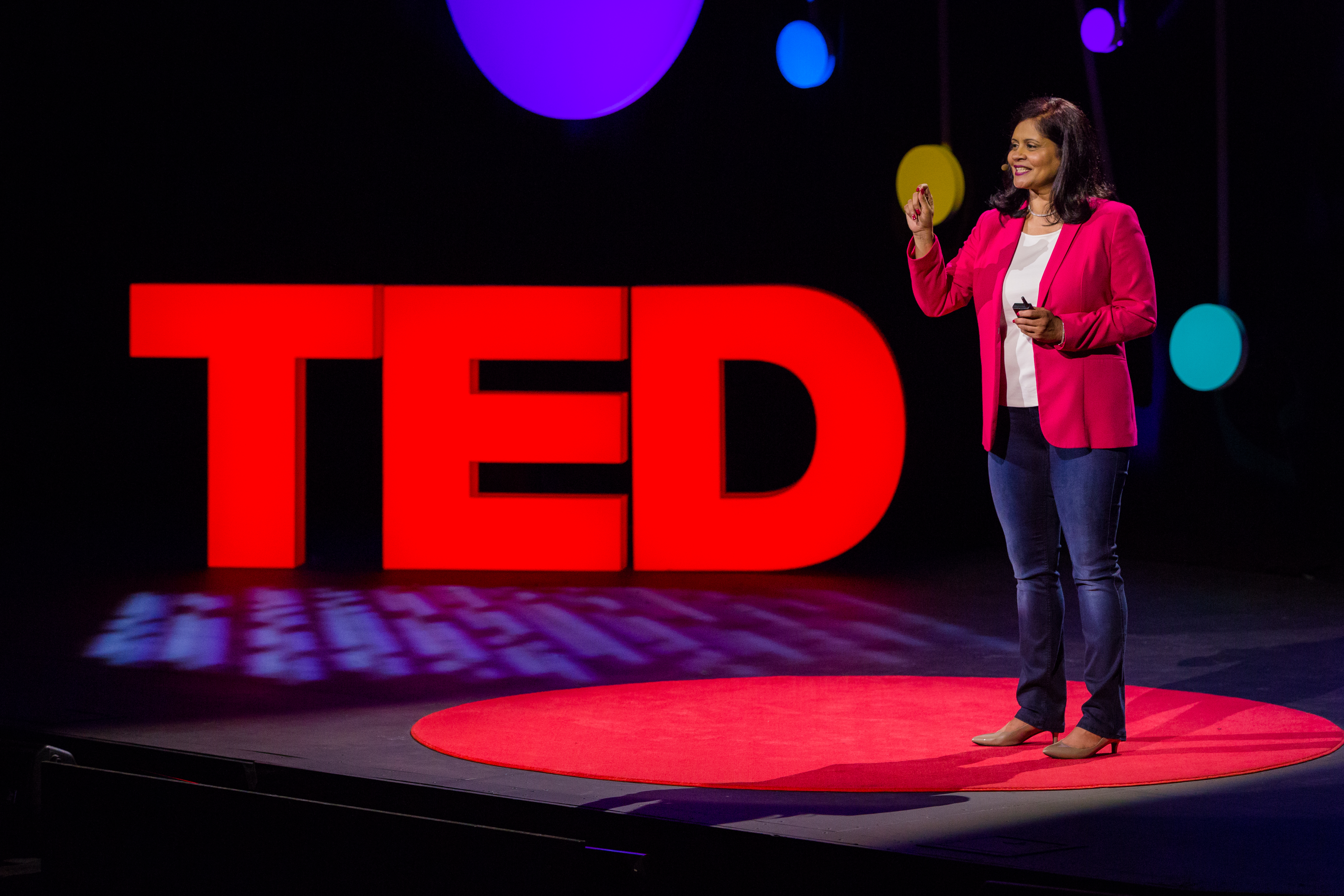
Aparna Mehta reveals the unseen world of “free” online returns, which often end up in landfills instead of back on the shelf. (Photo: Ryan Lash / TED)
Are free online returns really free? Every year, four billion pounds of returned clothing ends up in the landfill — the equivalent of every resident in the US doing a load of laundry and then throwing it straight in the trash. Why? Because sometimes it’s cheaper for a company to throw a returned item away than to make the effort of relabeling it and returning it to the shelf. Recovering shopaholic and retail consultant Aparna Mehta has the ideal vantage point to assess the scope of our online return addiction — and an ideal platform to do something about the waste it creates. Obviously, shoppers could take the extra time to decide what they truly need and purchase accordingly, but this is only a first step. Aparna has an idea to go a step further: “green-turns” instead of “returns.” “What if, when a person is trying to return something, it could go to the next shopper who wants it, and not the retailer?” Each unwanted item could be assessed electronically for condition, matched with someone who wants it and redirected accordingly. With the proper incentives built into the system to get shoppers to use it, “green-turns” could revolutionize the way we buy — and return — clothes online, Mehta says.
Simple, logistical steps we can take to eradicate world hunger. During a work trip to Uganda in 2016, food advocate Dan Canale was shocked to see how small inefficiencies caused serious delays to food shipments to refugee camps. For example, the lack of a forklift at one humanitarian organization’s warehouse meant it took three hours of manual labor to load a single truck. As a result of inefficiencies like these across food delivery systems, Canale estimates that nearly a third of the food produced globally ends up lost or wasted. That’s why he’s working to find solutions to shipping and delivery problems — offering action-based steps like diversifying the number of ports able to receive food and ensuring that food closest to expiration is shipped first. He encourages us to imagine: What if we used our most cutting-edge technology, like drones and military-grade aquatic vehicles, to deliver food to the hungry? By approaching these questions with innovation and zeal, Canale says, we can solve world hunger for good.
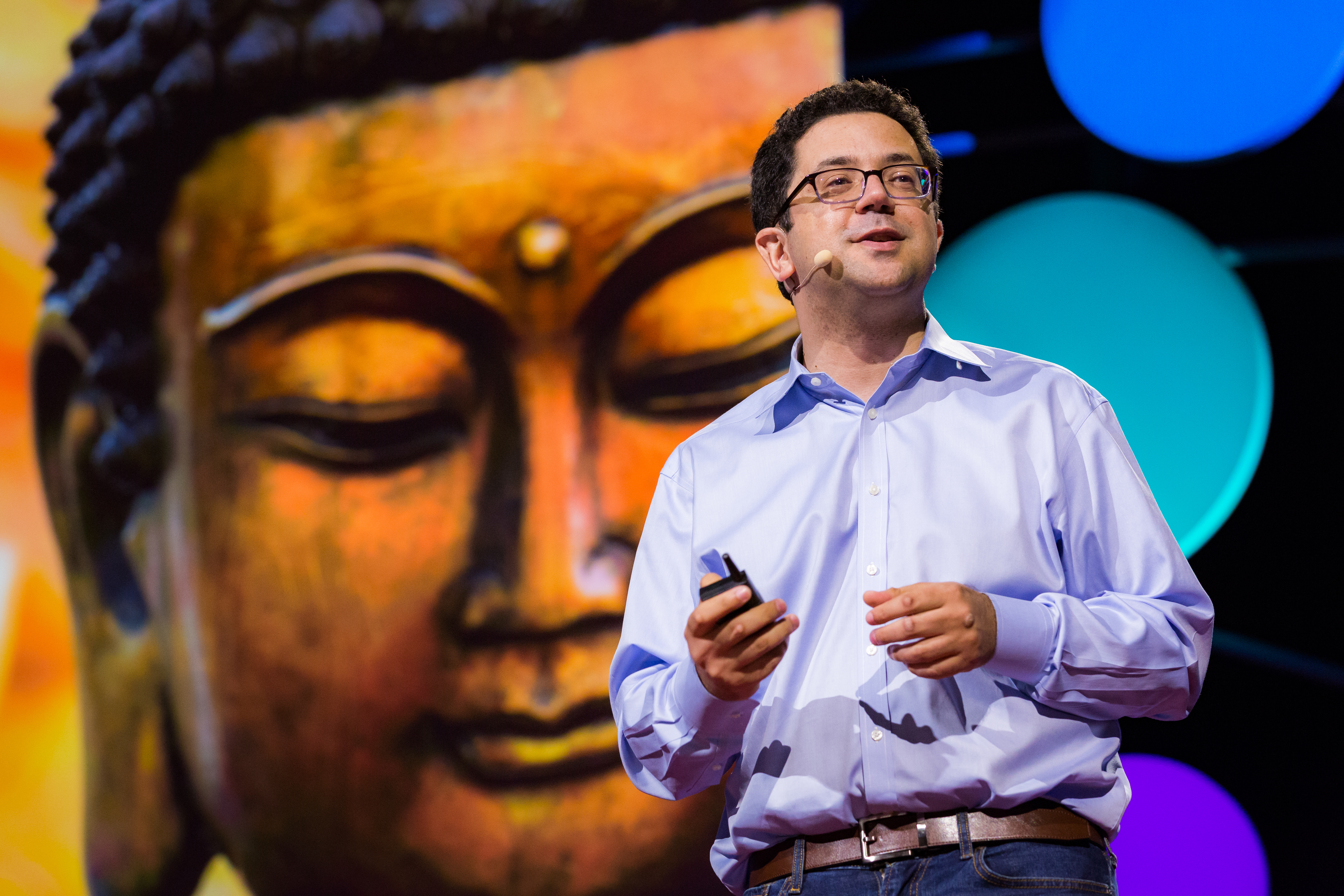
Global citizen Wanis Kabbaj shares some lessons for nationalists and globalists alike. (Photo: Ryan Lash / TED)
Moving beyond binary thinking. Why do we have to choose between nationalism and globalism, between loving our countries and caring for the world? Wanis Kabbaj has been grappling with this question for years — having lived in four continents, the debate between nationalism and globalism isn’t new to him. But the recent worldwide surge in nationalist fervor got him thinking: What if, instead of making a choice between the two, we took it on ourselves to challenge this binary thinking? He provides some interesting insights for nationalists and globalists. For those opposed to nationalism, he offers research showing how national satisfaction is more predictive of overall happiness than job satisfaction or household income. And for those who see globalism as evil, he provides compelling examples of how even national treasures like the Eiffel Tower, cricket or Italian home cooking are actually products of cross-cultural interaction.
Two poems on discovering and celebrating love. To close out session 1, poet Muslim Sahib performs two lyrical, humorous poems for the close-listening crowd. In his first piece, “The Coming Out Beauty,” Sahib weaves together religion, queerness, family and beauty, guiding the audience through his journey to self-love and encouraging them to recognize the beauty within themselves. In his second poem, “419 square feet,” he shares the bittersweet practice of finding love and building a home in what can be a restrictive world.
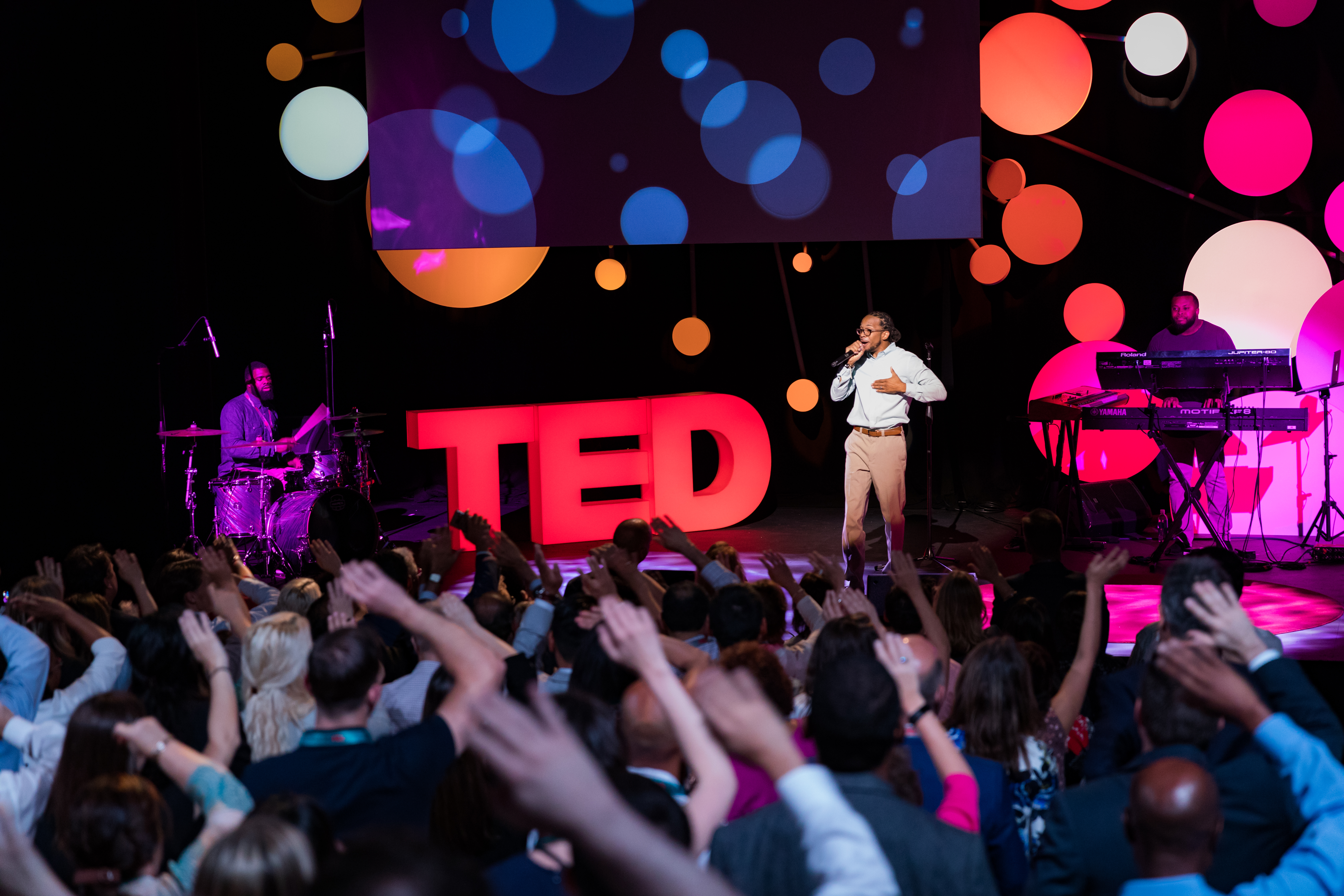
Musician and UPS package car driver John Bidden rocks the UPS stage with a performance of “Not About Me.” (Photo: Ryan Lash / TED)
To open Session 2, singer-songwriter and UPS package car driver John Bidden returns to the TED@UPS stage, performing an electrifying, reggae-tinged rendition of “Not About Me.”
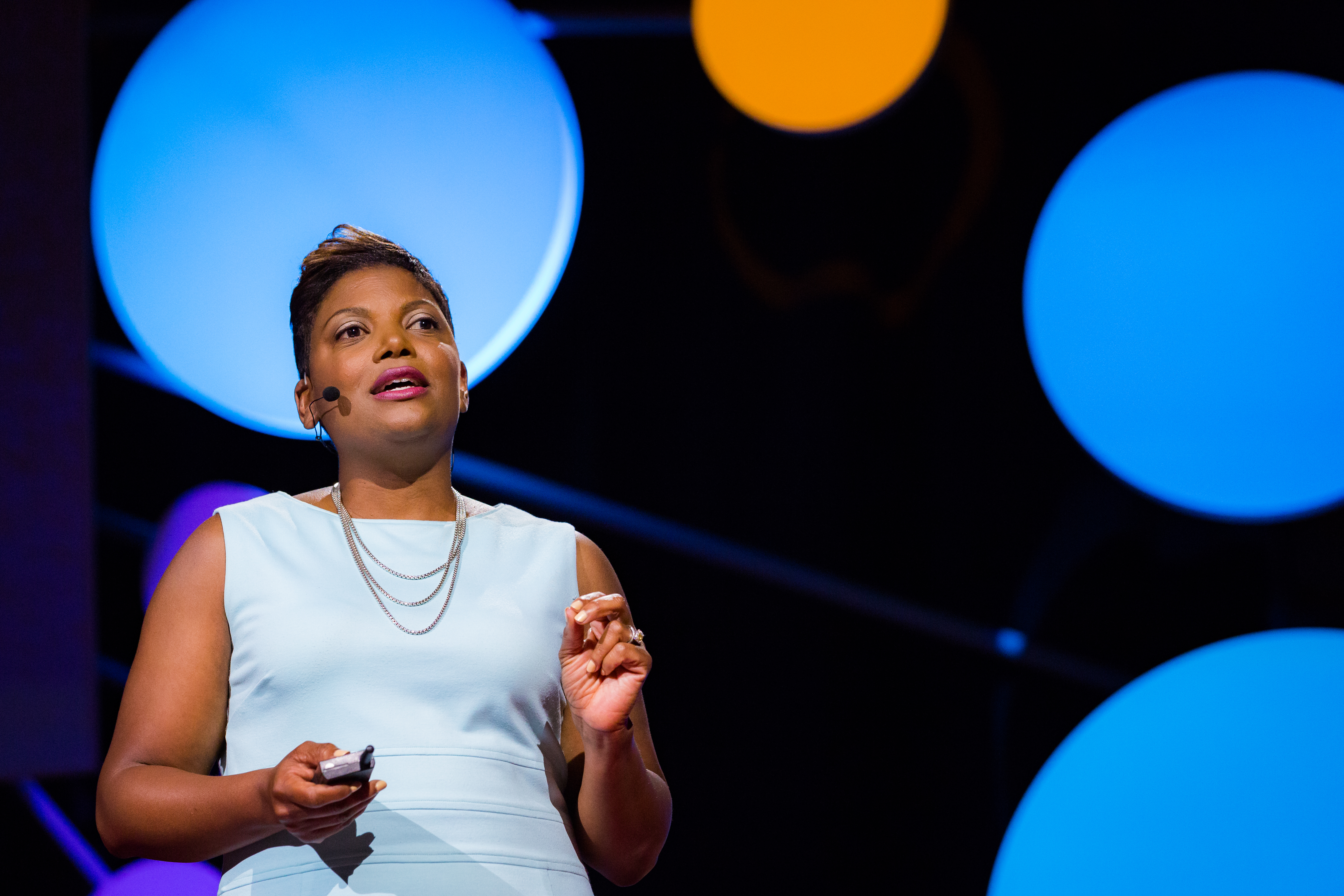
Anti-trafficking champion Nikki Clifton outlines three ways businesses can fight sex trafficking. (Photo: Ryan Lash / TED)
Businesses can help end sex trafficking. People may think there’s little overlap between the buttoned-up world of business and the criminal underworld of sex trafficking. But according to one survey, most johns — people who purchase sex — are employed, and web-based sex-buying tends to spike around 2pm. “These johns are likely buying sex in the middle of the workday,” says anti-trafficking champion Nikki Clifton. Businesses have a huge opportunity to reach the johns in their workplaces and to mobilize their employees and resources to fight against trafficking, Clifton suggests. She outlines a three-point plan, starting with the idea that businesses should state in their official employee handbook that sex buying at work, on company travel or with company resources is prohibited (and, of course, enforce this policy). Second, all employees should be trained to spot the signs of sex trafficking. For example, Clifton says, UPS teamed up with a group called Truckers Against Trafficking to educate its drivers about what to look for and who they can call for help. Third, businesses can figure out how they can use their special capabilities to combat sex trafficking. Clifton points to Visa, MasterCard and American Express — they joined forces and refused to process transactions from Backpage.com, an online sex-trafficking hub, which helped shut it down. “There are thousands of things that businesses can do; they just have to decide what to do to join the fight,” Clifton says.
Small business success: it takes a village. Nearly half of all US small businesses fail within their first five years, according to the Bureau of Labor Statistics — a figure that got small business strategist Ruchi Shah wondering: Is there a new model for entrepreneurial success? After shutting the doors of her own startup, Shah looked for answers from one group of consistently successful entrepreneurs: Guatemalan small business owners. Why? Because Guatemala and other developing countries use a microfinance approach called “village banking,” in which local entrepreneurs join together to get the loans and support they need to run their businesses. (The village banking concept was pioneered by social entrepreneur Muhammad Yunus, who won the Nobel Peace Prize for the idea in 2006.) Shah traveled to South America to study why village banks work, discovering three primary reasons: they give entrepreneurs a built-in team of advisors upfront; they adjust to customer needs; and they have a relentless focus on managing cash flow. Shah believes the idea of entrepreneurs having a vested interest in each other’s success can help build a strong foundation for any business, helping them weather the tough times with a diverse network of support. “Ultimately, it’s going to take more than our country’s determined entrepreneurs to improve our startup failure rates,” Shah says. “From what I have learned, it takes a village.”
Healthcare delivered at home. It’s time to fix our broken and obsolete hospital system, says healthcare futurist Niels van Namen. Beyond their general unpleasantness, hospitals present many logistical challenges: patients often have to travel long distances to reach them, especially for people living in remote areas, and many people avoid hospitals due to the costs, causing them to miss out on proper treatment altogether. For those who do get treatment, hospitals often make them sicker thanks to antibiotic-resistant bacteria that flourish in hospitals. “We have the opportunity to revolutionize the system,” van Namen says. “It is time to create a system that revolves around health care at home.” With recent innovations in medical technology (such as the at-home blood test), “homecare” presents a cheaper and more accessible alternative to hospital stays. In this setup, patients would receive treatment from the comfort of their homes and in the proximity of their families, while hospitals would become small, agile and mobile care centers focused on acute care. Homecare could also be a boon to rural areas, enabling a kind of sharing economy that matches people in need of care with someone who can provide a nearby home for treatment. “I am passionate to make the change and help ensure that patients, and not their diseases, are in control of their lives,” van Namen says.
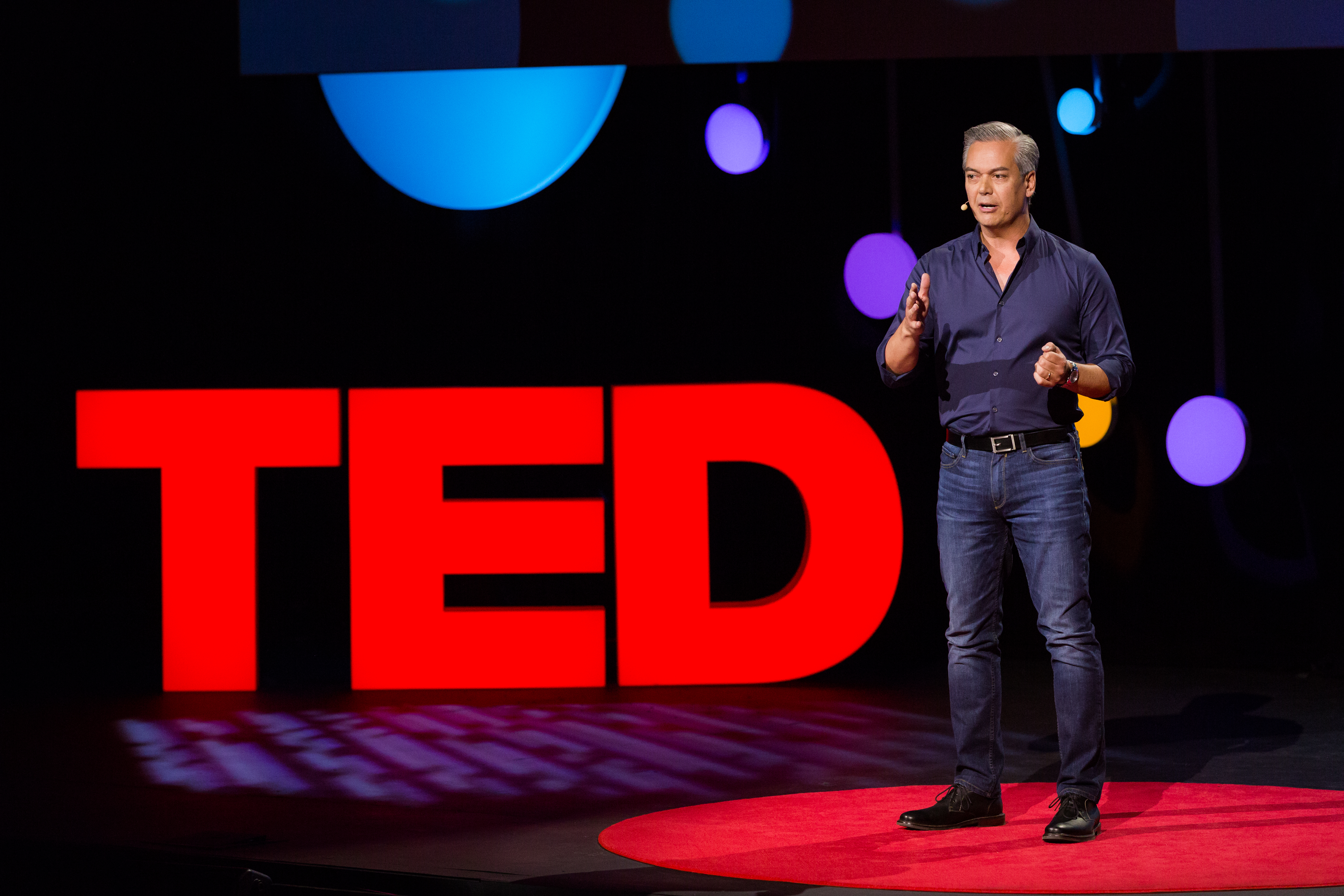
Robin Hooker asks: What new ideas could budding creatives bring to life if there was a makerspace in every town? (Photo: Ryan Lash / TED)
A makerspace in every town. While his friends were outside playing football, young Robin Hooker was in the garage with his dad, an Air Force mechanic, fusing iron with an oxyacetylene welder (and dodging the shoe-melting molten debris that would occasionally fly free). Hooker wasn’t just gaining a feel for design and learning his way around a workshop — he was learning that the world could be mashed-up, modded, repaired, reclaimed. Now he believes “we can transform the world by giving more people access to spaces like my dad’s garage” — what artisans now call “makerspaces.” Makerspaces are shared workshops that allow budding builders and designers to access the tools they need to create things — tools that otherwise would be prohibitively expensive. Perhaps more important, makerspaces offer inventors, hobbyists and tinkerers of diverse cultures, generations, genders and professions a chance to inspire each other to invent world-changing stuff. “What if entrepreneurs brought a makerspace to every town?” Hooker asks. “What new ideas could budding creatives bring to life?”
How to take back our online privacy. If someone broke into your house, chances are you’d take precautions to prevent it from happening again: new locks, a security alarm, increased insurance. Yet year after year, as massive data breaches sweep the internet, most of us have failed to safeguard our digital information. “We make the trade of online privacy for convenience,” says data privacy enthusiast Derek L. Banta. He’s working on a new way to protect people’s privacy called “anonymous commerce,” or “a-commerce.” Instead of giving your personal information to every website you visit, with a-commerce you’d give your information to a single, trusted third party. That third party would then secure your information and give you a personalized code to use when shopping online, serving as a kind of intermediary “avatar” between you and the brand. And what if the third party got hacked? The return on the hack would be less enticing, as hackers would only get access to one avatar at a time, instead of thousands of transactions. “In an a-commerce world, privacy is the business model,” Banta says. “We have an opportunity to hit the reset button on how we do business online. We can effectively disown the unintended consequences of being pioneers in the digital age.”
The dark side of disaster donations — and what you can do about it. In the aftermath of disaster, the world often responds with generosity and love, shipping thousands of boxes of resources to cities and countries healing from calamity. But what we’re not considering, says disaster relief expert Dale Herzog, is the logistical nightmare of receiving all of these donations. According to Herzog, the vast majority of disaster donations are destroyed — for example, a whopping 60 percent of donations sent to Haiti and Japan after natural disasters in 2010 and 2011 were thrown away. Herzog urges us to reconsider how we respond to disaster relief, suggesting that we replace that box of old clothes with a cash donation, and send an email or Tweet of support rather than mail a handwritten card. Instead of bogging relief organizations down with more stuff, we can donate in ways that help survivors recover and rebuild, Herzog says.
A silent national pandemic. In 2009, 11,341 untested rape kits — some dating back to the 1980s — were found in an abandoned warehouse where the Detroit police once stored evidence. When this scandal was uncovered, Wayne County Prosecutor Kym L. Worthy set a plan into action to get justice for the thousands of people affected, but she needed help to deal with the massive logistical challenges. In an eye-opening talk, Worthy explains how UPS supported her office and created a protocol to have these kits tracked and tested. As of June 2018, their partnership has led to more than 10,000 rape kits being tested, 2,600 identified suspects and historic state-wide laws being passed. But there is still a lot of work to be done — with more than 400,000 kits nationally that have yet to be tested and a rape culture that needs be fixed. The solution, says Worthy, will take inspired multi-industry collaboration.
Special thanks to the artists and filmmakers who contributed their work to TED@UPS.
Andrew Norton, Where Do Ideas Come From?
Fredrik Kasperi, Take On An Idea
Great Big Story, Laugh the Pain Away (Srsly)
Mainframe (North), For Approval
Issimo, Think A New Thought